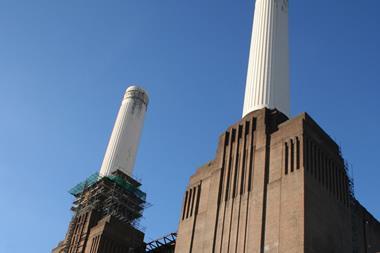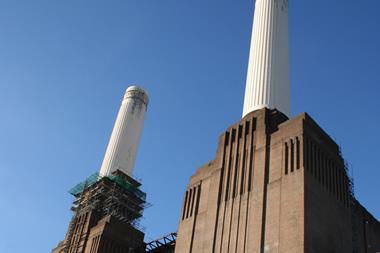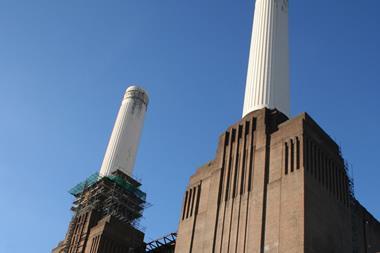Will a partner buy a major stake in Battersea Power Station, or will the project’s debts prove too difficult to overcome?

It is a jolting, uneasy ride on the 180 ft lift up Battersea Power Station’s southern wall. Not only is there a long drop, but extensive scaffolding reveals the depth of its disrepair. Site owner Real Estate Opportunities wants to restore this grade II*-listed monolith, and make it the centrepiece of a £5.5bn scheme, surrounded by 3,700 homes.
For 30 years, developers have been trying and failing to bring the power station back into use. The coming weeks will tell whether REO succeeds where so many others have failed, by securing a major investor partner, or whether its lenders finally lose patience with its plans.
Looking at the power station in April, REO’s dilemma seemed perfectly obvious. The size of three and a half football pitches, the station dwarfs Tate Modern, and would cost up to £150m to restore. More importantly, in a part of London that lends itself demographically to residential development, it hogs the Thameside views, neutralising the most valuable piece of
land on the site.
A source close to REO says: “The power station eats cash without giving much back.” Most cold-blooded property developers would have dismissed the Pink Floyd “flying pigs” album cover that sealed its mythical status, and tried to flatten it by now.
However, AIM-listed REO, which is 50.75% owned by Treasury Holdings, has pushed ahead, believing strongly in Battersea Power Station as a development site. For 18 months it has been trying to sell a stake in the 38 acre site it bought in 2006 for £400m.
In March 2010, it tried to sell 50% for £400m, valuing the consented scheme at £800m. It won planning consent in December of that year, but many in the market now value it at closer to £300m, a figure REO strongly disputes.
Debt watch
Watching this unfold, REO’s £250m senior lenders, Lloyds and NAMA (Ireland’s National Asset Management Agency), have extended its debt deadline once – on 31 May until next Wednesday 31 August.
Property Week understands veteran developer Godfrey Bradman visited REO and NAMA to negotiate to buy NAMA and Lloyds’s debt in an effort to take control of the site, but did
not conclude the deal.
Now, rather than sell 50% of the site, Treasury is offering to sell a larger slice of its interest in the site for sale, as it battles to reduce its debt burden. Whatever happens, it wants to remain as the development manager on the project.
Some buyers have been put off by Battersea’s difficult history. Roger Madelin, chief executive of King’s Cross Central developer Argent, says: “I’ve got loads of ideas for schemes if they want Argent to get involved, but the high entry cost is tough going.”
To make the project viable, REO filled the scheme with lucrative residential property, adding an extra 3,000 homes on to the proposals of previous owner Parkview. The new scheme requires a £600m extension to the Northern Line, for which REO would have to stump up more than £200m. Significantly, REO this week signed the section 106 agreement that committed it to this cost, but which also enhances the value of the site.
The problem of trying to get this infrastructure developed has gone right to the top of government: the coalition is understood to be considering how it can help to undertake the extension, ahead of a possible announcement at the Conservative Party conference in October.
Gary Yardley, investment director at London developer Capital & Counties, acknowledges this agreement’s importance: “You need a solution that is going to align the interests of all landowners [in Nine Elms]. I think the mayor and Wandsworth [council] need to take decisions on infrastructure together. I can’t see the public sector funding it in the current environment.”
With or without the Northern Line, significant hurdles remain. The scheme contains only two phases, so rather than using cash earned in a first small phase and recycling it into later tranches of development, it releases 1m sq ft of residential development on to the market at once.
“Deep pockets” are therefore a must, and received wisdom suggests that a development of this scale is better broken down into manageable, fundable, portions.Ian Marris, head of London residential development at Knight Frank, says: “It’s in the heart of central London and it’s underutilised. But to make it work financially, it’s got to be in broken down into bite-sized phases.”

Restoration project
Add all this to the cost of restoring the power station and in its present form, the scheme appears unviable, development sources argue. It is understood that Ernst & Young has been hired to examine the sales process the management has undertaken to ensure that it is the best route for lenders to get their money back.
The firm will also provide advice on alternative strategies that could be pursued by the lenders – including insolvency. However, sources close to the project say Lloyds fully backs the REO team’s Battersea plans.
After Property Week revealed Ernst & Young’s appointment last Friday, REO said: “REO notes the press comment made today regarding Battersea Power Station … a number of offers have now been received and final discussions to conclude the investment process are taking place.
“The lending banks, Lloyds Banking Group and NAMA, are supporting this process. Ernst & Young are advising the lending banks in regard to Battersea Power Station, including specific advice in respect of the investment process, including the review of the incoming proposals.”
Berkeley, British Land, Capital & Counties and Blackstone are all known to have seriously considered an involvement in Battersea in the past six months, but none could make the numbers work.
City sources believe Treasury’s links to the Far East – it has several development projects in China – will have helped it to find an equity investor from that booming part of the world. But REO refuses to shed any light on who these investors might be.
A spokesman says: “In late 2010, REO started a global roadshow to decide on which equity partner(s) it wished to work with to fund the post-planning permission development of Battersea Power Station (BPS).
“The search for such a partner was compliant with the strategy REO adopted since it acquired BPS in 2006 – it would fund site acquisition, expansion and the obtaining of planning permission.
“Part of the structural steps that were required to allow an equity partner to invest was the demerger of BPS into a SPV (BPSSV Ltd) and this demerger was not completed until May 2011.
“BPSSV is now in active final discussions with several parties to conclude the equity partnership, and several offers have been made. When completed, the equity partnership would allow the repayment of the existing banks’ facilities and the injection of fresh funds for the development phases and this process has been fully supported by the lending banks, including Lloyds.
“There have been no new valuations of the Battersea Power Station since February 2011, when it was valued at £500m.” As the saga drags on, still the power station crumbles. Architect Sir Terry Farrell believes the case for keeping it standing has weakened.
“The argument for putting Battersea Power Station back together again is still there, but it is a big cost impediment. I think it’s time for a reassessment of the whole thing. The only reason they say ’conference centre’ [as a potential use for the power station] is because they’re puzzled about what to do.”
REO has made clear to Property Week that it has no intention of demolishing Battersea Power Station. Keith Garner, the Battersea Power Station Community Group’s spokesman, says: “Things have got worse under Treasury. For as long as I’ve been involved, the plans have always been going to start the year after next.”
Indeed, as things stand, even 2013 would be an optimistic start date. If REO can find a buyer bold enough to carry out its plans, development would begin within months, but in a sales process that has lasted one and a half years, no buyer has emerged – yet.
With REO in active talks with prospective buyers and the latest debt maturity date approaching, the next key stage of Battersea Power Station’s development saga is fast approaching.
Update - letter from Treasury Holdings
Dear Sir,
Battersea’s Power Play, 26 August 2011
As managers of the Battersea Power Station project, I am sorry to see that there a significant number of inaccuracies in your article and misleading statements by contributors because of a lack of knowledge of the full facts about Battersea Power Station. I list these below:
1. The article refers to “site owner Real Estate Opportunities”, but the site is owned by Battersea Power Station Shareholder Vehicle Limited.
2. The article states that for 30 years developers have been trying and failing to bring the Power Station back into use. This is not correct. There have only been two owners of the site, one was a theme park operator whose proposal failed, and the other was Victor Hwang and his family who successfully secured the first commercial planning consent and almost doubled the size of the site through acquisition. They increased the value by over £350m – hardly a failure.
3. Real Estate Opportunities plc is not “AIM-listed” as stated; it is listed on the Official List of the UK Listing Authority and trades on the Main Market of the London Stock Exchange.
4. It is not correct that for 18 months REO has been trying to sell a stake in the site.
5. The article states that “in March 2010 [REO] tried to sell 50% for £400m”. This is not true – we didn’t even having planning permission until December 2010 and were therefore not in a position to secure investment.
6. In relation to the valuation of the site, the current Stock Exchange valuation is £500m, which is only £50psf of the area for which planning permission has been granted. In fact the site next to the Power Station sold for £100psf of consented area.
7. Contrary to the impression given by one of the quotes in the article there is no problem about “a solution that is going to align the interests of all landowners [in Nine Elms]” in relation to the Northern Line extension. The extension already has the full backing of all the land owners, TFL, GLA, Wandsworth Council, Lambeth Council London underground and the Government, That is a great deal of alignment.
8. The article states that the scheme contains only two phases, but in fact it has 7 main phases, each broken into an average of 5 sub-phases – that is 35 phases, not 2.
9. It is not correct that potential investors mentioned in the article withdrew because they could not make the numbers work. The site now has the benefit of a very viable planning consent.
10. The article does not make it clear that the conference centre referred to in a quote from Sir Terry Farrell is a very small part of the Power Station design (less than 10%), and the building is viable in its own right. It is not the case that REO has identified a conference centre as a potential use for the Power Station “because they are puzzled about what to do”. The addition of a conference centre to the use mix fills a large gap in London’s current business infrastructure provision (as witnessed by the previous Mayor’s attempts to create a new Conference Centre for London). Treasury Holdings have specific conference centre expertise, owning and operating Dublin’s state of the art National Convention Centre, widely acknowledged to be one of Europe’s finest.
11. One of the contributors to your article suggested that Battersea Power Station should be demolished, but this takes no account of the fact that the Power Station is listed and can’t be demolished. In any event REO believes that it is the key to value because of the brand power it has.
12. One of the suggestions by your contributors was to turn the Power Station into a shopping centre. In fact the scheme currently contains 1.2m sq ft of retail space and has been zoned as a town centre. Next to Stratford, it is the biggest retail centre in the South of England.
I shall be grateful if you will publish this letter to inform your readers of the true position.
Your sincerely,
Robert Tincknell
Managing Director
Treasury Holdings




What the experts say about Battersea Power Station’s prospects
Gary Yardley, investment director, Capital & Counties
“Why don’t people consider the value enhancement that would take place from demolishing it? It would be worth hundreds of millions more if it were demolished and that money could go towards funding the Northern Line extension. All schemes have a ’hockey stick’ cashflow effect blocking development. With Nine Elms, you’ve got the Tube and Battersea Power Station.”
Sir Terry Farrell
“It’s a very powerful form on the London skyline. But it’s a headache. It would be sad to demolish it, but it is at the point where there is a case for that. There is an argument for turning it into a glorious ruin, like a giant Stonehenge or Fountains Abbey.”
Matthew Bonning Snook, executive director, Helical Bar
“Turn the power station into a shopping centre. If you parachute in a retail scheme, the whole thing is going to fly. There is so much demand for a good retail centre south of the river and people would get there, whether by bike car or otherwise. At present, the south-west London “yummy mummy” belt has nowhere to go.”
Nick Cuff, chairman of the planning committee, Wandsworth Borough Council
“We want to see the building brought back to use. The permission the council negotiated protects the building in the early phases of implementation. It would be a huge loss to London to see Battersea Power Station go.”






























No comments yet